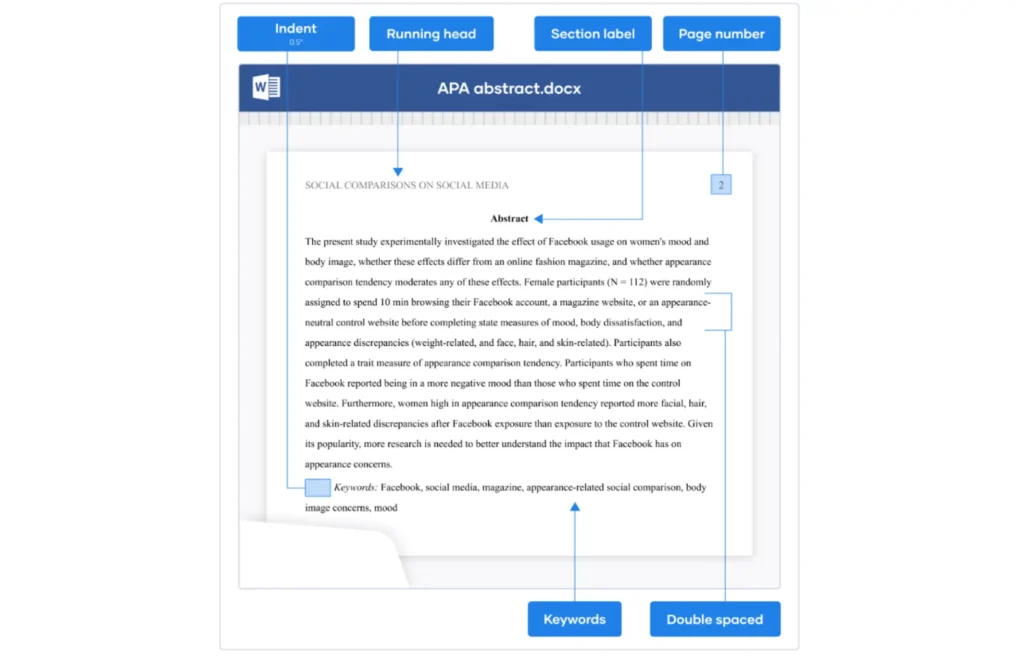The abstract is a concise yet comprehensive summary of your entire research paper. Despite its brief length of 150-250 words, it acts as a preview for readers, allowing them to quickly grasp the key elements of your study. It is featured on a dedicated page immediately following the title page.
When writing your abstract:
- State the primary objectives and research questions
- Summarize the essential findings and results
- Discuss the conclusions and implications
An abstract is generally required and expected for professional manuscripts submitted for publication consideration. However, an abstract is not typically needed for student papers and smaller academic assignments unless specifically requested by the instructor.
How to format the abstract
APA abstract example

Formatting instructions
Here are the guidelines for properly formatting the abstract in APA style:
- Include a running head and page number in the header for professional papers. Student papers do not require a running head.
- Adjust all page margins to 1 inch or 2.54 cm.
- Center and boldface the heading “Abstract” at the top of a new page.
- Begin the abstract content itself on the next line after the heading:
- Do not indent the first line of the abstract paragraph
- Double-space the entire paragraph
- Use a readable 12 pt font like Times New Roman
- Strictly limit the word count to 250 words maximum
- Directly after the abstract paragraph, you may optionally list 3-5 relevant keywords:
- Indent the first line of keywords 0.5 inches
- Italicize the label “Keywords:”
- List each keyword in lowercase with commas between them
- Do not include a period after the final keyword
How to write an APA abstract
The abstract provides a comprehensive yet concise overview of your entire research paper. It is generally best to write it after completing the main sections of your paper.
Structure your abstract by methodically addressing the following key points:
- Establish the research objective – What core problem, question, or hypothesis did your study aim to address? Outline the motivating goals.
- Describe the methodology – What research methods, participants, materials, and analysis procedures did you employ to explore the issue?
- Present the key findings – Summarize your research investigation’s notable results, statistical data, and conclusions.
- Discuss the implications – Explain how your findings add value, offer new understanding, or suggest further areas for examination.
Which keywords to use
After the abstract paragraph, you can list several focused keywords. If your research paper is published and included in academic databases, these keywords act as indexing terms to aid in its discoverability.
It is crucial to carefully select keywords that accurately represent the core components of your study. Aim to identify significant words and phrases that capture the central topic, research methodology, participant characteristics, or other key variables examined.
The APA guidelines recommend including between three to five keywords in total. This provides sufficient scope to highlight the most pertinent concepts and elements that future researchers may utilize when searching for literature in your study area.
With thoughtful keyword selection, you increase the likelihood that your published work will appear prominently in relevant search results. This enhanced visibility can drive higher readership, citation rates, and overall impact within your academic field.
Example: Identifying relevant keywords
Let’s say your research paper examined the impact of the Mediterranean diet on cardiovascular health risk factors in middle-aged adults.
Title: Effects of the Mediterranean Diet on Cardiovascular Risk Factors in Middle-Aged Adults
Some relevant keywords to consider could include:
- Mediterranean diet
- Cardiovascular disease
- Risk factors
- Cholesterol
- Blood pressure
- Obesity
- Dietary patterns
- Middle age
- Lifestyle intervention
You could select the 3-5 most representative keywords from this list. An effective set might be:
Mediterranean diet, cardiovascular disease, cholesterol, blood pressure, middle-age
This covers the main dietary focus (Mediterranean diet), the health condition of interest (cardiovascular disease), two key risk factors studied (cholesterol and blood pressure), and the population sample (middle age).
Alternatively, you could go with:
Mediterranean diet, risk factors, obesity, dietary patterns, lifestyle intervention
This highlights the dietary approach, the focus on mitigating health risks, the issue of obesity, the examination of overall dietary habits, and the positioning of it as a lifestyle-based intervention.